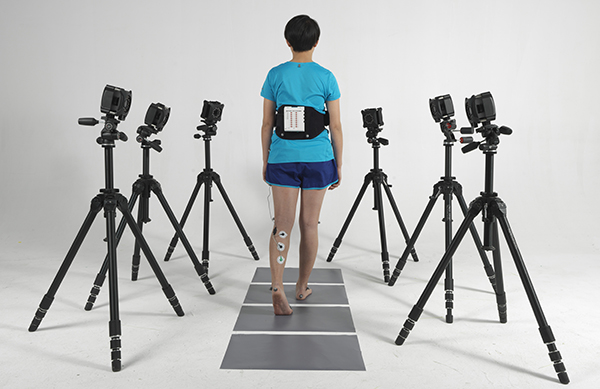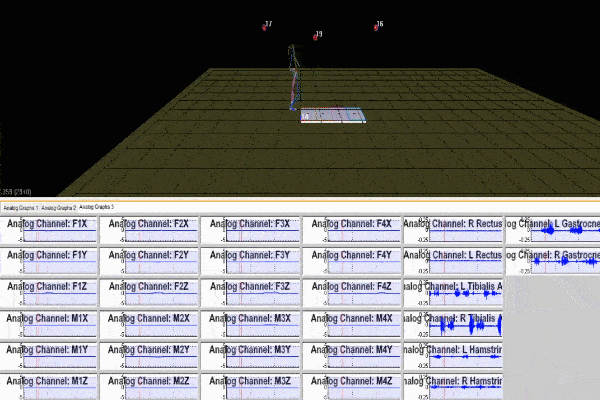Gait analysis is primarily applied in clinical medical diagnostics to analyze abnormal movement behaviors. It is used in departments like orthopedics and rehabilitation in hospitals, and for research and analysis in fields such as sports human science, rehabilitation medicine, and psychology in higher education institutions.

Diseases that cause abnormal movements in patients can be categorized into five types: deformities, muscle weakness, sensory loss, pain, and impaired movement control. There are many causes for these diseases. For example, joint contractures and congenital clubfoot can lead to deformities. Monitoring and quantifying abnormal gait behaviors due to these diseases is important for determining the specific conditions of the patients and for establishing treatment plans.
The 3D Gait Analysis System includes an infrared optical motion capture system, surface electromyography, force platforms, and wearable metabolic monitoring systems among other advanced equipment. It precisely acquires a subject's body behavior parameters, significantly contributing to gait analysis research.
Introduction to the 3D Gait Analysis System

The 3D Gait Analysis System operates on biomechanical principles, detecting and recording data during the human walking process. This includes specific phases of trunk and joint movement, muscle activity, force exerted on the ground, joint torque and work done, as well as plantar pressure distribution and oxygen consumption while walking. By comparing these data points with normal reference ranges, key abnormal imaging factors and compensatory changes can be identified. This system provides recommendations and references for clinical diagnosis, decision-making, and evaluating treatment effectiveness.
Composition of the 3D Gait Analysis System
3D Gait Analysis System
The core device for measuring patient gait uses continuous real-time feedback by monitoring and tracking specific reflective markers on the target to achieve non-invasive, continuous dynamic measurement. This facilitates the motion capture task in gait analysis and acquires kinematic data.

The NOKOV motion capture system, targeting the field of gait analysis, has a specialized reflective marker placement model based on related project experience to ensure comprehensive optimization of capturing effects.

The kinematic data gathered primarily include parameters such as position, velocity, acceleration, reaction time, distance, flexion-extension, adduction-abduction, rotation, step frequency, stride length, walking speed, and user-defined angles, among others.
3D Force Plate
During the gait process, there's a phase called the "support phase," where the limb bears significant forces in three dimensions on the ground: vertical, anterior-posterior, and medial-lateral. These forces' magnitude and direction change as the body shifts its position through the supporting limb.

Via 3D Force Measuring PlatformCapable of effectively obtaining ground reaction forces, torque, and power data during this stage, the analysis of these data helps understand the mechanics of gait and obtain precise mechanical parameters for abnormal gaits.
Surface Electromyography (EMG) Analysis System
Surface electromyography (EMG) analysis systems capture electrical signals from muscles to determine the periodicity and relative strength of muscle functions. They assess changes in muscle activity duration and exercise intensity that lead to gait abnormalities, which are helpful for making more accurate determinations of the causes of gait abnormalities.

In the fields of motion analysis and sports rehabilitation, data from force platforms and electromyography (EMG) is often synchronized to obtain kinematic data, which is then analyzed in conjunction with mechanics and anatomy.
NOKOV 3D motion analysis system application examples
Tongji University Affiliated Yangzhi Rehabilitation Hospital

By integrating a 3D Gait Analysis System with devices such as motion capture systems and 3D force platforms, research is conducted on gait analysis of cerebral palsy patients, maximum respiratory measurement, scoliosis measurement, and more.
Yueyang Hospital of Integrated Traditional Chinese and Western Medicine, affiliated with Shanghai University of Traditional Chinese Medicine
The gait analysis lab, assembled using motion capture systems, 3D force measuring platforms, surface electromyography, and foot pressure distribution, has considerable clinical experience in the study of children's gait analysis.
Case Details Link:https://www.nokov.com/support/case_studies_detail/gait-analysis.html
Additionally, universities like Tianjin Medical University, South China University of Technology, and Peking University are equipped with 3D Gait Analysis Systems primarily for motion capture, which support research in prosthetics development and gait analysis for the elderly.